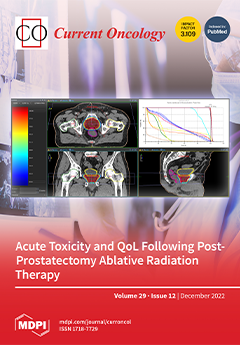Purpose: Biomarker discordances and alterations can be encountered between tru-cut biopsy and residual tumor in breast cancer treated with neoadjuvant chemotherapy (NACTx). We aimed to investigate the effect of NACTx on major biomarker expression (ER, PR, HER2, Ki-67) and tumor grade, the frequency
[...] Read more.
Purpose: Biomarker discordances and alterations can be encountered between tru-cut biopsy and residual tumor in breast cancer treated with neoadjuvant chemotherapy (NACTx). We aimed to investigate the effect of NACTx on major biomarker expression (ER, PR, HER2, Ki-67) and tumor grade, the frequency and causes of receptor discordances, and the clinical significance of changes in terms of adjuvant therapy need and chemosensitivity. Methods: In this retrospective study, ER, PR, HER2, and Ki-67 expression and tumor grades were compared between pre- and post-NACTx tumor samples using the Wilcoxon signed-rank test. The frequencies of receptor discordances and the need for new adjuvant therapy due to discordances were calculated. The effect of patient and tumor characteristics and NACTx regimens on discordances was investigated using multivariate analysis. Using histopathological examinations, residual tumors were divided into chemotherapy-responsive and chemotherapy-unresponsive tumors. Biomarker changes in both groups were analyzed for predictability of chemosensitivity. Results: Of the 169 patients who received NACTx, 102 patients having enough residual tumors in the surgical pathology specimen were enrolled in the study. Histopathologically, about 70% of tumors were partially responsive to NACTx and 30% were unresponsive (chemo-resistant). The concordance and discordance rates were 95.1% versus 4.9% for ER (
p = 0.180), 97.1% versus 2.9% for PR (
p = 0.083), and 89.2% versus 10.8% for HER2 (
p = 0.763), respectively. In addition, 15% of hormone receptor (HR)-negative patients became HR(+) and 5.7% of HER2(−) patients became HER2(+) in the residual tumors, requiring adjuvant endocrine or anti-HER2 therapy. In particular, 18% of triple-negative patients became HR(+) and 12% became HER2(+). HER2 loss was detected in 40% of HER2(+) patients. Multivariate logistic regression analysis revealed that lower estrogen expression (
p = 0.046), a smaller tumor size (
p = 0.029), and anti-HER2 therapy (
p < 0.001) have independent efficacy on ER discordance, PR discordance, and HER2 discordance, respectively. Ki-67 and PR expression significantly decreased in chemotherapy-responsive tumors (
p = 0.001 and
p = 0.004), and the tumor grade increased in chemotherapy-unresponsive tumors (
p = 0.034). Conclusions: Approximately 3–5% of HR discordance and about 10% of HER2 discordance can be observed in breast cancer after currently used NACTx regimens. Discordances are bi-directional (from positive to negative and vice versa), and their causes are multifactorial; they should be assessed accordingly. The NACTx effect alone cannot explain observed discordances but can cause biomarker alterations. The change in receptor status from positive to negative, especially HER2 loss, is mainly associated with the NACTx effect. However, the shift from negative to positive is thought to be primarily related to intratumoral heterogeneity. Receptor statuses becoming positive are of more clinical importance due to adjuvant therapy requirements. Biomarker alterations in PR, Ki-67, and tumor grade can provide predictive information about tumor chemosensitivity.
Full article






